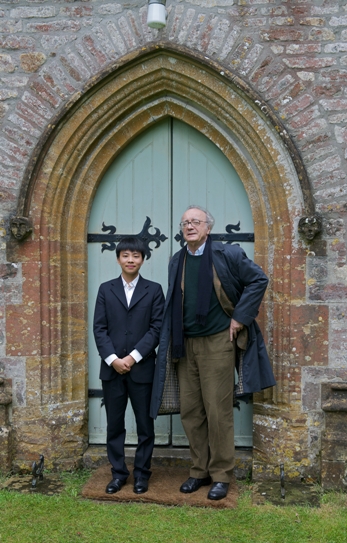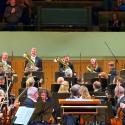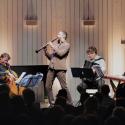When Alfred Brendel first mentioned Kit Armstrong to me, in early 2008, I knew there was a film there. He was brimming with excitement: Kit had come to him with an interpretation of a Chopin Nocturne that displayed a command and maturity that was baffling considering Kit was 13 at the time of the recording. Alfred led me into his inner sanctum, a practice room filled to bursting with two Steinways, a large carved idol from New Guinea, Liszt’s death mask and a rich and varied collection of paintings and images, some of them revealing the pianist’s wicked Dadaist sense of humour. He slipped the CD into the player, his eyes sparkling with enthusiasm.
For Alfred Brendel to approve of a pianist’s Chopin was remarkable: he had once told me that he’d left the composer alone as Alfred Cortot’s Chopin could not be bettered. It was the Nocturne he now played me that decided Alfred to teach Kit Armstrong - the first child pianist he had ever taken on.
When I suggested to Alfred’s manager Tom Hull that I wanted to make a film about the master and his young apprentice, he warned that they were shielding Kit from media attention, as they – wisely - didn’t want him spun into another celeb prodigy. He was in fact already very present on YouTube, playing Bach ridiculously well at six, his feet barely reaching the pedals. There had even been, so the rumour went, a number of fake Kit Armstrongs floating around the web. I argued that we shouldn’t delay recording the evolution of this unique teacher-pupil relationship, adding that I wouldn’t release any of the footage until the time was right. But the answer remained a firm "No".
 Nine months later, I was summoned to tea with Alfred and Kit and told that they had decided to go ahead with the film. I had made a documentary about Alfred eight years before, Alfred Brendel, Man and Mask, the only major portrait film he had ever permitted. The collaboration had gone well. I was back at Alfred’s house a week or so later, filming the first of many lessons, in a process which lasted two years. The crowded practice room was not ideal fly-on-the-wall filming territory. My sound engineer Mary Milton had to squeeze between the two grand pianos and the wall. I was hampered by a very limited amount of camera angles. Shooting was made easier by the small size of my digital camera, but being a fly on the wall was still a challenge: I felt more like the elephant in the practice room, knocking precious objects off shelves as I tried to move around without disturbing the magic of the delicate teaching dialogue that unfolded before us.
Nine months later, I was summoned to tea with Alfred and Kit and told that they had decided to go ahead with the film. I had made a documentary about Alfred eight years before, Alfred Brendel, Man and Mask, the only major portrait film he had ever permitted. The collaboration had gone well. I was back at Alfred’s house a week or so later, filming the first of many lessons, in a process which lasted two years. The crowded practice room was not ideal fly-on-the-wall filming territory. My sound engineer Mary Milton had to squeeze between the two grand pianos and the wall. I was hampered by a very limited amount of camera angles. Shooting was made easier by the small size of my digital camera, but being a fly on the wall was still a challenge: I felt more like the elephant in the practice room, knocking precious objects off shelves as I tried to move around without disturbing the magic of the delicate teaching dialogue that unfolded before us.
Both Alfred and Kit are ambivalent about the camera. They are born performers but shy as well. Making documentaries allows the film-maker to penetrate other people’s worlds in a unique and privileged way, even when it is clear that the people you film are conscious of the camera or not sure they really want you there at all. There are, however, those magical times when spontaneous emotion overrides the care which the subjects devote to nurturing an image. I was around Kit and Alfred long enough to capture some of these moments. The evidence of what goes on between them is often barely perceptible, in a glance or a revealing bit of body language. As Kit’s German manager Julia Nees suggests in the film, “They are kindred spirits”: there is something deep that passes between them and which goes beyond the mere imparting of wisdom, technique and musical interpretation. Both men are fiercely brilliant in their own individual ways but they also share an off-centre quirkiness and sense of the absurd which counter-balances their cerebral intensity.
Over the next 24 months, the relationship changed: Kit became more confident and open with his teacher, and his playing progressed by leaps and bounds. Alfred worked hard at freeing Kit’s spirit from the mixed blessing of technical virtuosity, trying, as he put it to me, “to set the piano stool on fire”. Kit, like Yehudi Menuhin and other child prodigies, Alfred explained, came into playing the piano with an uncanny grasp of the emotional content of the music. You can only guess how prodigies achieve this. As they develop, such extraordinary talents have to find emotional territory of their own to draw on, and the film is partly a chronicle of Kit’s initiation into the world of musical passion.
There was an elegiac quality to the filming too, as during the course of the two years, Alfred retired from public performance. Although he refuses – with some justification, as he has had other immensely talented pupils - to acknowledge Kit as his spiritual heir, it is impossible not to see as one of the film’s narrative strands the old master passing the baton to the young prodigy, in an age-old celebration of the ritual of master-apprentice initiation. Alfred, ever the perfectionist, has never been easy about his performances being filmed; it's got harder rather than easier as the decades have gone by. The only recent material came from a session I filmed at Snape Maltings in 2000. I asked if I could film his last UK recital at the Music at Plush festival in the summer of 2008, as I knew that Kit would be in the audience. Alfred refused. In the end, he allowed me to shoot the encores – Bach, Schubert and Liszt. The Liszt provides one of the most moving moments in the film, as we see Kit visibly moved as he watches his teacher in a moment of exquisite communion with one of his own "masters".
The French title to the film is La transmission and "transmission" is what the film is largely about. This has been a theme in several of my music films – a portrait of the great pianist Leon Fleisher, who can claim to be the last in a line of pianistic apostolic succession that goes back to Beethoven via Artur Schnabel and Czerny; Ravi Shankar, whose pupils shared his home, in the ancient Indian tradition of the guru-shishya relationship; and finally, in Soweto Strings, the film about the work of viola player Rosemary Nalden in the South African townships, an inspired process of initiation that liberates disadvantaged young people through the healing power of music.
I am grateful that Alfred and Kit granted us access. They weren’t always happy having a film crew around but there is now a unique document which records exceptional moments in piano teaching as well as some of Alfred Brendel’s considerable wisdom and experience. I also hope that the film communicates something of the subtle power of transmission, in a way that makes sense not just in terms of music. But the film is, in the end, a celebration of music-making of the highest order, made up of moments stolen from a master and apprentice as they work their way towards something close to perfection.
- Set The Piano Stool on Fire is at the Curzon Mayfair and Curzon Richmond from 4 June. Alfred Brendel and Kit Armstrong are in conversation after the Curzon Mayfair screening on 4 June
- Mark Kidel introduces the film is also at the Bristol Watershed on 5 June
- Kit Armstrong performs at St George's Bristol on 10 June and Wigmore Hall on 12 June
 Find Mark Kidel's newly released DVD of The Brendel Lectures on Amazon
Find Mark Kidel's newly released DVD of The Brendel Lectures on Amazon















Add comment